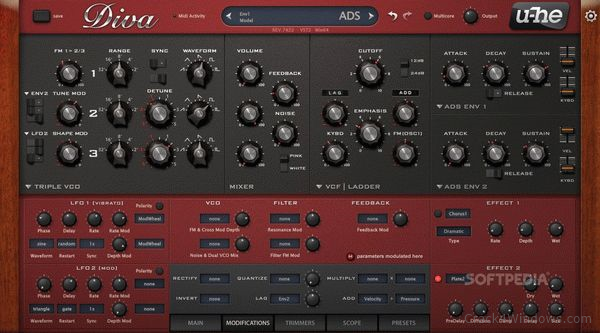October 18 2023
Diva 1.4.7 (Revision 15105) Keygen Full Version

Download Diva
-
甚至作为数码音乐制作的工具变得越来越先进,用于发出的声音的第一次电子仪器从来没有真的消失。 声音从过去的时代确实有很强大的车辆,用于那些想要旅行下的记忆里,但他们也是吸引年轻的音乐家,可能很快变得着迷的音乐文物。 勇敢的人甚至会试图实现复古听到他们的作品,但是你可以肯定的是,只有少数人能买得起一个穆格或其他条古老的设备。
那些喜欢的模拟声音,还有,幸运的是,许多有用的软件解决方案。 今天我们要去看一个音频插件称为神。
迪瓦代表的恐龙模仿虚拟模拟合成器,所以不要指望这个程序有任何特别的女性特征。 事实上,该接口看起来老了,与其边界仿效的合成木制面板。
现在,只是因为这是应该的声音和觉得自己老了,并不意味着潜遭受了太多的限制。 你会发现许多预设的,可以很容易地纳入现代化的组合,同时自己的声音可能被修改过的一系列广泛的参数。
在上半的接口,你会发现五个振荡器和五个过滤器型号,以及其他参数,这些参数的基础是经典的合成器的设计。 你可以很容易地交换机之间的这些参数;现在,我应该提到的接口是令人惊讶的是直觉,一些,因为我所知道的,不是特的古老的合成器。
在底部的一半,你会发现两个Lfo,两个效的单位和四个可以互换的部分在中间。 虽然主要的、修改和修剪器包含许多其他的参数,我着迷的设计范围,这可视化的波形的,你玩音乐。
我可以很容易地得出结论,女主角是一个非常精心设计的虚拟工具,将最呼吁所有爱质量模拟的声音。
-
यहां तक कि जब डिजिटल संगीत उत्पादन उपकरण अधिक से अधिक उन्नत हो जाते हैं, तो पहले इलेक्ट्रॉनिक उपकरणों द्वारा किए गए ध्वनियों के लिए प्यार वास्तव में दूर नहीं होता है। पिछले युगों की ध्वनियों में वास्तव में शक्तिशाली वाहन हैं जो उन लोगों के लिए हैं जो स्मृति लेन पर यात्रा करना चाहते हैं, लेकिन वे छोटे संगीतकारों को भी आकर्षित करते हैं जो जल्दी से पुराने की संगीत कलाकृतियों से मोहित हो सकते हैं। बहादुर भी अपनी प्रस्तुतियों में रेट्रो ध्वनियों को लागू करने की कोशिश करेंगे, लेकिन आप यह सुनिश्चित कर सकते हैं कि उनमें से कुछ ही प्राचीन उपकरणों के मोग या अन्य टुकड़ों को खरीद सकते हैं।
उन लोगों के लिए जो एनालॉग ध्वनियों के शौकीन हैं, सौभाग्य से, कई उपयोगी सॉफ़्टवेयर समाधान हैं। आज हम दिवा नामक एक ऑडियो प्लगइन पर एक नज़र डालने जा रहे हैं।
दिवा डायनासॉर इंप्रूव करने वाले वर्चुअल एनालॉग सिंथेसाइज़र के लिए खड़ा है, इसलिए इस कार्यक्रम से किसी विशेष स्त्री सुविधाओं की उम्मीद नहीं है। वास्तव में, इंटरफ़ेस पुराने देखने के लिए बना है, इसकी सीमाओं के साथ सिंथेटिक लकड़ी के साइड पैनल की नकल है।
अब, सिर्फ इसलिए कि यह ध्वनि और पुरानी लगने वाली है, इसका मतलब यह नहीं है कि गोता बहुत अधिक सीमाओं से ग्रस्त है। आपको ऐसे कई प्रीसेट मिलेंगे, जिन्हें समकालीन रचनाओं में आसानी से एकीकृत किया जा सकता है, जबकि ध्वनियों को कई प्रकार के मापदंडों के माध्यम से संशोधित किया जा सकता है।
इंटरफ़ेस के ऊपरी आधे हिस्से में, आपको पाँच ऑसिलेटर और पाँच फ़िल्टर मॉडल मिलेंगे, साथ ही साथ अन्य पैरामीटर भी होंगे जो अन्य सिंथेटिक डिज़ाइनों पर आधारित हैं। आप आसानी से इन मापदंडों के बीच स्विच कर सकते हैं; अब तक, मुझे यह उल्लेख करना चाहिए कि इंटरफ़ेस आश्चर्यजनक रूप से सहज ज्ञान युक्त है, कुछ ऐसा, जहाँ तक मुझे पता है, पुराने synths की विशेषता नहीं है।
नीचे के आधे हिस्से में, आपको दो LFO, दो प्रभाव इकाइयाँ, और बीच में चार विनिमेय अनुभाग मिलेंगे। जबकि Main, Modifications, and Trimmers में कई अन्य पैरामीटर हैं, मुझे स्कोप के डिज़ाइन से मोहित किया गया था जो कि आपके द्वारा संगीत बजाने पर तरंगों की कल्पना करता है।
मैं आसानी से यह निष्कर्ष निकाल सकता हूं कि दिवा एक बहुत अच्छी तरह से डिज़ाइन किया गया आभासी उपकरण है जो गुणवत्ता वाले एनालॉग ध्वनियों को पसंद करने वाले सभी लोगों के लिए सबसे अधिक आकर्षक होगा।
-
Even as digital music production tools become more and more advanced, the love for the sounds made by the first electronic instruments never really fades away. The sounds from past eras indeed have are powerful vehicles for those who want to take trips down memory lane, but they also attract younger musicians that may quickly become fascinated with the musical artifacts of old. The brave ones will even try to implement retro sounds into their productions, but you can be sure that only a few of them can afford a Moog or other pieces of ancient equipment.
For those that are fond of analog sounds, there are, fortunately, many helpful software solutions. Today we’re going to take a look at an audio plugin called Diva.
Diva stands for Dinosaur Impersonating Virtual Analogue synthesizer, so don’t expect this program to have any particular feminine features. In fact, the interface is made to look old, with its borders imitating synth wooden side panels.
Now, just because it’s supposed to sound and feel old, doesn’t mean that Dive suffers from too many limitations. You’ll find many presets that can easily be integrated into contemporary compositions, while the sounds themselves can be modified through a wide array of parameters.
In the upper half of the interface, you’ll find five oscillators and five filters models, as well as other parameters that are based on classic synth designs. You can easily switch between these parameters; by now, I should mention that the interface is surprisingly intuitive, something that, as far as I know, isn’t characteristic of the old synths.
In the bottom half, you’ll find two LFOs, two effect units, and four interchangeable sections in the middle. While Main, Modifications, and Trimmers contain numerous other parameters, I was fascinated with the design of the Scope which visualizes the waveforms as you play music.
I can easily conclude that Diva is a very well-designed virtual instrument that will be most appealing to all who love quality analog sounds.
Leave a reply
Your email will not be published. Required fields are marked as *




